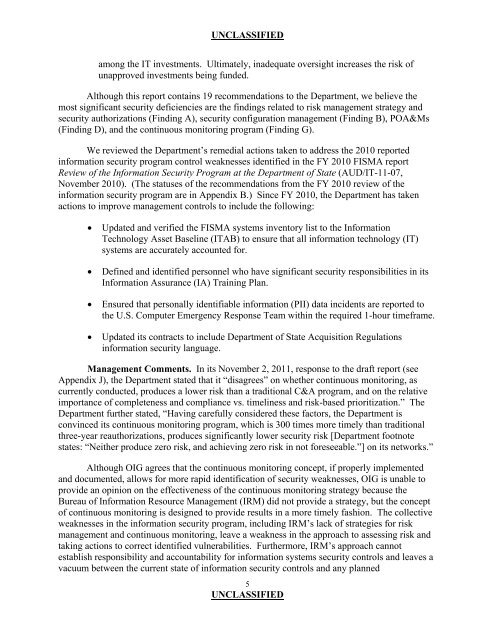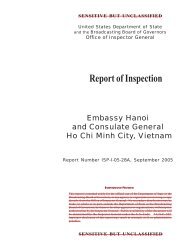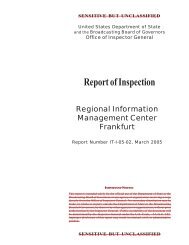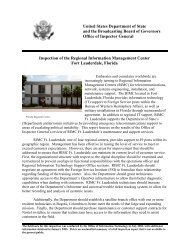Evaluation of Department of State Information Security Program ...
Evaluation of Department of State Information Security Program ...
Evaluation of Department of State Information Security Program ...
Create successful ePaper yourself
Turn your PDF publications into a flip-book with our unique Google optimized e-Paper software.
UNCLASSIFIED<br />
among the IT investments. Ultimately, inadequate oversight increases the risk <strong>of</strong><br />
unapproved investments being funded.<br />
Although this report contains 19 recommendations to the <strong>Department</strong>, we believe the<br />
most significant security deficiencies are the findings related to risk management strategy and<br />
security authorizations (Finding A), security configuration management (Finding B), POA&Ms<br />
(Finding D), and the continuous monitoring program (Finding G).<br />
We reviewed the <strong>Department</strong>’s remedial actions taken to address the 2010 reported<br />
information security program control weaknesses identified in the FY 2010 FISMA report<br />
Review <strong>of</strong> the <strong>Information</strong> <strong>Security</strong> <strong>Program</strong> at the <strong>Department</strong> <strong>of</strong> <strong>State</strong> (AUD/IT-11-07,<br />
November 2010). (The statuses <strong>of</strong> the recommendations from the FY 2010 review <strong>of</strong> the<br />
information security program are in Appendix B.) Since FY 2010, the <strong>Department</strong> has taken<br />
actions to improve management controls to include the following:<br />
� Updated and verified the FISMA systems inventory list to the <strong>Information</strong><br />
Technology Asset Baseline (ITAB) to ensure that all information technology (IT)<br />
systems are accurately accounted for.<br />
� Defined and identified personnel who have significant security responsibilities in its<br />
<strong>Information</strong> Assurance (IA) Training Plan.<br />
� Ensured that personally identifiable information (PII) data incidents are reported to<br />
the U.S. Computer Emergency Response Team within the required 1-hour timeframe.<br />
� Updated its contracts to include <strong>Department</strong> <strong>of</strong> <strong>State</strong> Acquisition Regulations<br />
information security language.<br />
Management Comments. In its November 2, 2011, response to the draft report (see<br />
Appendix J), the <strong>Department</strong> stated that it “disagrees” on whether continuous monitoring, as<br />
currently conducted, produces a lower risk than a traditional C&A program, and on the relative<br />
importance <strong>of</strong> completeness and compliance vs. timeliness and risk-based prioritization.” The<br />
<strong>Department</strong> further stated, “Having carefully considered these factors, the <strong>Department</strong> is<br />
convinced its continuous monitoring program, which is 300 times more timely than traditional<br />
three-year reauthorizations, produces significantly lower security risk [<strong>Department</strong> footnote<br />
states: “Neither produce zero risk, and achieving zero risk in not foreseeable.”] on its networks.”<br />
Although OIG agrees that the continuous monitoring concept, if properly implemented<br />
and documented, allows for more rapid identification <strong>of</strong> security weaknesses, OIG is unable to<br />
provide an opinion on the effectiveness <strong>of</strong> the continuous monitoring strategy because the<br />
Bureau <strong>of</strong> <strong>Information</strong> Resource Management (IRM) did not provide a strategy, but the concept<br />
<strong>of</strong> continuous monitoring is designed to provide results in a more timely fashion. The collective<br />
weaknesses in the information security program, including IRM’s lack <strong>of</strong> strategies for risk<br />
management and continuous monitoring, leave a weakness in the approach to assessing risk and<br />
taking actions to correct identified vulnerabilities. Furthermore, IRM’s approach cannot<br />
establish responsibility and accountability for information systems security controls and leaves a<br />
vacuum between the current state <strong>of</strong> information security controls and any planned<br />
5<br />
UNCLASSIFIED








